Wettability of Carbonate Reservoir Rocks: A Comparative Analysis
Abstract
:1. Introduction
2. Wettability Measurement Methods
3. Materials and Experiments
3.1. Plug Samples and Routine Tests
3.2. SCAL Tests and Fluids
4. Results and Discussion
5. Conclusions
- Generally speaking, good agreement was obtained between the relative permeability-based methods and Amott, Amott–Harvey, and USBM* techniques in identifying the wetness of carbonate samples, despite such methods being based on different concepts and physics. Thus, it is convenient to use relative permeability-based methods when the required data for the Amott–Harvey and USBM* methods are not available.
- There was a good correlation between the USBM* and the Amott–Harvey methods as well as between the Lak and the modified Lak approaches. Intermediate correlations were observed among the other methods.
- Comparing the wettability indices with rock quality indicators showed that as FZI, RQI, and Winland R35 increased (or rock quality improved), samples became more oil-wet.
- Rock quality indices RQI and Winland R35 that are mainly a function of pore throats and their sizes were correlated with wettability indices higher than the FZI.
- The Lak and modified Lak indices, as two quantitative relative permeability-based wettability techniques, provided higher correlations with rock quality indicators than the Amott–Harvey and USBM* indices. Those wettability indices strongly affected by wetting characteristics of larger pore throats were higher correlated to rock quality indicators than indices taking into account the effect of both small and large pore throats.
Author Contributions
Funding
Institutional Review Board Statement
Informed Consent Statement
Data Availability Statement
Acknowledgments
Conflicts of Interest
References
- Anderson, W.G. Wettability literature survey-part 1: Rock/oil/brine interactions and the effects of core handling on wettability. J. Pet. Technol. 1986, 38, 1125–1144. [Google Scholar] [CrossRef]
- Anderson, W.G. Wettability Literature Survey-Part 3: The Effects of Wettability on the Electrical Properties of Porous Media. J. Pet. Technol. 1986, 38, 1371–1378. [Google Scholar] [CrossRef]
- Anderson, W.G. Wettability literature survey-part 4: Effects of wettability on capillary pressure. J. Pet. Technol. 1987, 39, 1283–1300. [Google Scholar] [CrossRef]
- Anderson, W.G. Wettability literature survey part 5: The effects of wettability on relative permeability. J. Pet. Technol. 1987, 39, 1453–1468. [Google Scholar] [CrossRef]
- Anderson, W.G. Wettability literature survey-part 6: The effects of wettability on waterflooding. J. Pet. Technol. 1987, 39, 1605–1622. [Google Scholar] [CrossRef]
- Liaw, S.-P.; Dhir, D.V.K. Effect of surface wettability on transition boiling heat transfer from a vertical surface. In Proceedings of the International Heat Transfer Conference, San Francisco, CA, USA, 17–22 August 1986. [Google Scholar]
- Zhou, D.; Stenby, E.H. A Percolation Study of Wettability Effect on the Electrical Properties of Reservior Rocks. Transp. Porous Media 1997, 29, 85–98. [Google Scholar] [CrossRef]
- Wen, D.S.; Wang, B.X. Effects of surface wettability on nucleate pool boiling heat transfer for surfactant solutions. Int. J. Heat Mass Transf. 2002, 45, 1739–1747. [Google Scholar] [CrossRef]
- Hsu, C.-C.; Chen, P.-H. Surface wettability effects on critical heat flux of boiling heat transfer using nanoparticle coatings. Int. J. Heat Mass Transf. 2012, 55, 3713–3719. [Google Scholar] [CrossRef]
- Beltrán, A.; Hernández-Díaz, D.; Chávez, O.; García, A.; Mena, B.; Zenit, R. Experimental study of the effect of wettability on the relative permeability for air–water flow through porous media. Int. J. Multiph. Flow 2019, 120, 103091. [Google Scholar] [CrossRef]
- Rücker, M.; Bartels, W.B.; Bultreys, T.; Boone, M.; Singh, K.; Garfi, G.; Scanziani, A.; Spurin, C.; Yesufu-Rufai, S.; Krevor, S.; et al. Workflow for Upscaling Wettability from the Nanoscale to Core Scale. Petrophysics SPWLA J. Form. Eval. Reserv. Descr. 2020, 61, 189–205. [Google Scholar]
- Armstrong, R.T.; Sun, C.; Mostaghimi, P.; Berg, S.; Rücker, M.; Luckham, P.; Georgiadis, A.; McClure, J.E. Multiscale Characterization of Wettability in Porous Media. Transp. Porous Media 2021, 140, 215–240. [Google Scholar] [CrossRef]
- Mirzaei-Paiaman, A.; Faramarzi-Palangar, M.; Djezzar, S.; Kord, S. A new approach to measure wettability by relative permeability measurements. J. Pet. Sci. Eng. 2022, 208, 109191. [Google Scholar] [CrossRef]
- Farahani, M.; Aghaei, H.; Asadolahpour, S.R. Sensitivity of unsteady-state gas-water relative permeability to experimental artefacts and interpretation techniques; case study from a gas reservoir in south Iran. J. Nat. Gas Sci. Eng. 2019, 71, 102998. [Google Scholar] [CrossRef]
- Mirzaei-Paiaman, A. New methods for qualitative and quantitative determination of wettability from relative permeability curves: Revisiting Craig’s rules of thumb and introducing Lak wettability index. Fuel 2021, 288, 119623. [Google Scholar] [CrossRef]
- Torsaeter, O. A comparative study of wettability test methods based on experimental results from North Sea reservoir rocks. In Proceedings of the SPE Annual Technical Conference and Exhibition, Houston, TX, USA, 2–5 October 1988. [Google Scholar]
- Lake, L.W. Enhanced Oil Recovery; Prentice Hall: Englewood Cliffs, NJ, USA, 1989. [Google Scholar]
- Jadhunandan, P.; Morrow, N.R. Effect of wettability on waterflood recovery for crude-oil/brine/rock systems. SPE Reserv. Eng. 1995, 10, 40–46. [Google Scholar] [CrossRef]
- Morrow, N.R. Wettability and Its Effect on Oil Recovery. J. Pet. Technol. 1990, 42, 1476–1484. [Google Scholar] [CrossRef]
- Rao, D.N. Wettability Effects in Thermal Recovery Operations. SPE Reserv. Eval. Eng. 1999, 2, 420–430. [Google Scholar] [CrossRef]
- Agbalaka, C.C.; Dandekar, A.Y.; Patil, S.L.; Khataniar, S.; Hemsath, J. The Effect Of Wettability On Oil Recovery: A Review. In Proceedings of the SPE Asia Pacific Oil and Gas Conference and Exhibition, Perth, Australia, 20–22 October 2008. [Google Scholar]
- Iglauer, S.; Pentland, C.H.; Busch, A. CO2 wettability of seal and reservoir rocks and the implications for carbon geo-sequestration. Water Resour. Res. 2015, 51, 729–774. [Google Scholar] [CrossRef] [Green Version]
- Arif, M.; Abu-Khamsin, S.A.; Iglauer, S. Wettability of rock/CO2/brine and rock/oil/CO2-enriched-brine systems:Critical parametric analysis and future outlook. Adv. Colloid Interface Sci. 2019, 268, 91–113. [Google Scholar] [CrossRef]
- Daryasafar, A.; Keykhosravi, A.; Shahbazi, K. Modeling CO2 wettability behavior at the interface of brine/CO2/mineral: Application to CO2 geo-sequestration. J. Clean. Prod. 2019, 239, 118101. [Google Scholar] [CrossRef]
- Bennion, D.B.; Thomas, F.B.; Sheppard, D.A. Formation Damage Due to Mineral Alteration and Wettability Changes During Hot Water and Steam Injection in Clay-Bearing Sandstone Reservoirs. In Proceedings of the SPE Formation Damage Control Symposium, Lafayette, LA, USA, 26–27 February 1992. [Google Scholar]
- Schembre, J.M.; Kovscek, A.R. Thermally Induced Fines Mobilization: Its Relationship to Wettability and Formation Damage. In Proceedings of the SPE International Thermal Operations and Heavy Oil Symposium and Western Regional Meeting, Bakersfield, CA, USA, 16–18 March 2004. [Google Scholar]
- Zhang, X.; Ge, J.; Kamali, F.; Othman, F.; Wang, Y.; Le-Hussain, F. Wettability of sandstone rocks and their mineral components during CO2 injection in aquifers: Implications for fines migration. J. Nat. Gas Sci. Eng. 2020, 73, 103050. [Google Scholar] [CrossRef]
- Zhou, X.; Morrow, N.R.; Ma, S. Interrelationship of wettability, initial water saturation, aging time, and oil recovery by spontaneous imbibition and waterflooding. SPE J. 2000, 5, 199–207. [Google Scholar] [CrossRef]
- Graue, A.; Aspenes, E.; Bognø, T.; Moe, R.; Ramsdal, J. Alteration of wettability and wettability heterogeneity. J. Pet. Sci. Eng. 2002, 33, 3–17. [Google Scholar] [CrossRef] [Green Version]
- Zhang, Y.; Zeng, J.; Qiao, J.; Feng, X.; Dong, Y. Investigating the Effect of the Temperature and Pressure on Wettability in Crude Oil–Brine–Rock Systems. Energy Fuels 2018, 32, 9010–9019. [Google Scholar] [CrossRef]
- Salathiel, R.A. Oil Recovery by Surface Film Drainage In Mixed-Wettability Rocks. J. Pet. Technol. 1973, 25, 1216–1224. [Google Scholar] [CrossRef]
- Anderson, W.G. Wettability literature survey-part 2: Wettability measurement. J. Pet. Technol. 1986, 38, 1246–1262. [Google Scholar] [CrossRef]
- Amott, E. Observations relating to the wettability of porous rock. Trans. AIME 1959, 216, 156–162. [Google Scholar] [CrossRef]
- Boneau, D.; Clampitt, R.L. A surfactant system for the oil-wet sandstone of the North Burbank Unit. J. Pet. Technol. 1977, 29, 501–506. [Google Scholar] [CrossRef]
- Trantham, J.; Clampitt, R.L. Determination of oil saturation after waterflooding in an oil-wet reservoir the North Burbank Unit, Tract 97 Project. J. Pet. Technol. 1977, 29, 491–500. [Google Scholar] [CrossRef]
- Donaldson, E.C.; Thomas, R.D.; Lorenz, P.B. Wettability determination and its effect on recovery efficiency. Soc. Pet. Eng. J. 1969, 9, 13–20. [Google Scholar] [CrossRef]
- Sharma, M.; Wunderlich, R. The alteration of rock properties due to interactions with drilling-fluid components. J. Pet. Sci. Eng. 1987, 1, 127–143. [Google Scholar] [CrossRef]
- Craig, F.F. The Reservoir Engineering Aspects of Waterflooding; Henry L. Doherty Memorial Fund of AIME: New York, NY, USA, 1971; Volume 3. [Google Scholar]
- Ferreira, F.C.; Pairoys, F.; Klemin, D.V.; Baser-Langenau, B.; Safonov, S.; Dinariev, O.; Evseev, N.; Silva, M.D.; Carneiro, G.D.F. Innovative Workflow for Grouping, Averaging, End-Point Scaling and Assessing Uncertainty of Water-Oil Relative-Permeability Curves, Considering Corresponding Normalized Water-Fractional-Flow Curves, Reservoir-Rock Types and Wettability Indexes. In Proceedings of the Abu Dhabi International Petroleum Exhibition & Conference, Abu Dhabi, United Arab Emirates, 13–16 November 2017. [Google Scholar]
- Ma, S.M.; Zhang, X.; Morrow, N.R.; Zhou, X. Characterization of Wettability From Spontaneous Imbibition Measurements. J. Can. Pet. Technol. 1999, 38. [Google Scholar] [CrossRef]
- Mirzaei-Paiaman, A.; Masihi, M.; Standnes, D.C. Index for characterizing wettability of reservoir rocks based on spontaneous imbibition recovery data. Energy Fuels 2013, 27, 7360–7368. [Google Scholar] [CrossRef]
- Mirzaei-Paiaman, A.; Saboorian-Jooybari, H.; Masihi, M. Incorporation of viscosity scaling group into analysis of MPMS index for laboratory characterization of wettability of reservoir rocks. J. Pet. Explor. Prod. Technol. 2017, 7, 205–216. [Google Scholar] [CrossRef] [Green Version]
- Denekas, M.; Mattax, C.; Davis, G. Effects of crude oil components on rock wettability. Trans. AIME 1959, 216, 330–333. [Google Scholar] [CrossRef]
- Ghedan, S.G.; Canbaz, C.H. Theory and experimental setup of the new Rise in Core reservoir wettability measurement technique. In Proceedings of the IPTC 2014: International Petroleum Technology Conference, Doha, Qatar, 19–22 January 2014. [Google Scholar]
- Fleury, M.; Deflandre, F. Quantitative evaluation of porous media wettability using NMR relaxometry. Magn. Reson. Imaging 2003, 21, 385–387. [Google Scholar] [CrossRef]
- Al-Mahrooqi, S.; Grattoni, C.; Muggeridge, A.; Zimmerman, R.W.; Jing, X. Pore-scale modelling of NMR relaxation for the characterization of wettability. J. Pet. Sci. Eng. 2006, 52, 172–186. [Google Scholar] [CrossRef]
- Chen, J.; Hirasaki, G.; Flaum, M. NMR wettability indices: Effect of OBM on wettability and NMR responses. J. Pet. Sci. Eng. 2006, 52, 161–171. [Google Scholar] [CrossRef]
- Looyestijn, W.; Zhang, X.; Hebing, A. How Can NMR Assess the Wettability of a Chalk Reservoir. In Proceedings of the International Symposium of the Society of Core Analysts, Vienna, Austria, 27 August–1 September 2017. [Google Scholar]
- Tandon, S.; Newgord, C.; Heidari, Z. Wettability Quantification in Mixed-Wet Rocks Using a New NMR-Based Method. SPE Reserv. Eval. Eng. 2020, 23, 0896–0916. [Google Scholar] [CrossRef]
- Dick, M.J.; Veselinovic, D.; Bonnie, R.J.M.; Kelly, S. NMR Quantification of Wettability and Water Uptake in Unconventionals. In Proceedings of the SPE/AAPG/SEG Unconventional Resources Technology Conference, Houston, TX, USA, 26–28 July 2021. [Google Scholar] [CrossRef]
- Treiber, L.E.; Owens, W.W. A Laboratory Evaluation of the Wettability of Fifty Oil-Producing Reservoirs. Soc. Pet. Eng. J. 1972, 12, 531–540. [Google Scholar] [CrossRef]
- Chilingar, G.V.; Yen, T.F. Some Notes on Wettability and Relative Permeabilities of Carbonate Reservoir Rocks, II. Energy Sources 1983, 7, 67–75. [Google Scholar] [CrossRef]
- Al-Yousef, H.Y.; Lichaa, P.M.; Al-Kaabi, A.U.; Alpustun, H. Wettability Evaluation of a Carbonate Reservoir Rock from Core to Pore Level. In Proceedings of the Middle East Oil Show, Manama, Bahrain, 11–14 March 1995. [Google Scholar]
- Webb, K.J.; Black, C.J.J.; Namba, T. Resolving Wettability in a Giant Carbonate Reservoir. In Proceedings of the Abu Dhabi International Petroleum Exhibition and Conference, Abu Dhabi, United Arab Emirates, 13–16 October 1996. [Google Scholar]
- Marzouk, I. Wettability and Saturation in Abu Dhabi Carbonate Reservoirs. In Proceedings of the Middle East Oil Show and Conference, Manama, Bahrain, 20–23 February 1999. [Google Scholar]
- Okasha, T.M.; Funk, J.J.; Al-Enezi, S.M.; Al-Rashidi, H.N. Fifty years of wettability measurements in the arab-d carbonate. In Proceedings of the International Symposium of the Society of Core Analysts, Abu Dhabi, United Arab Emirates, 5–9 October 2004. [Google Scholar]
- Okasha, T.M.; Funk, J.J.; Rashidi, H.N. Fifty Years of Wettability Measurements in the Arab-D Carbonate Reservoir. In Proceedings of the SPE Middle East Oil and Gas Show and Conference, Manama, Bahrain, 11–14 March 2007. [Google Scholar]
- Al-Attar, H.H.; Mahmoud, M.Y.; Zekri, A.Y.; Almehaideb, R.; Ghannam, M. Low-salinity flooding in a selected carbonate reservoir: Experimental approach. J. Pet. Explor. Prod. Technol. 2013, 3, 139–149. [Google Scholar] [CrossRef] [Green Version]
- Bakhshi, E.; Torab, F.M. Determining Wettability of Fractured Carbonate Reservoirs. Nat. Resour. Res. 2016, 25, 211–225. [Google Scholar] [CrossRef]
- Chen, S.-Y.; Kaufman, Y.; Kristiansen, K.; Seo, D.; Schrader, A.M.; Alotaibi, M.B.; Dobbs, H.A.; Cadirov, N.A.; Boles, J.R.; Ayirala, S.; et al. Effects of Salinity on Oil Recovery (the “Dilution Effect”): Experimental and Theoretical Studies of Crude Oil/Brine/Carbonate Surface Restructuring and Associated Physicochemical Interactions. Energy Fuels 2017, 31, 8925–8941. [Google Scholar] [CrossRef]
- Faramarzi-Palangar, M.; Mirzaei-Paiaman, A. Investigating dynamic rock quality in two-phase flow systems using TEM-function: A comparative study of different rock typing indices. Pet. Res. 2021, 6, 16–25. [Google Scholar] [CrossRef]
- Burkhardt, J.A.; Ward, M.B.; McLean, R.H. Effect of Core Surfacing and Mud Filtrate Flushing on Reliability of Core Analysis Conducted on Fresh Cores. In Proceedings of the Fall Meeting of the Society of Petroleum Engineers of AIME, Houston, TX, USA, 5–8 October 1958. [Google Scholar]
- Mohanty, K.K. Multiphase Flow in Porous Media: III. Oil Mobilization, Transverse Dispersion, and Wettability. In Proceedings of the SPE Annual Technical Conference and Exhibition, San Francisco, CA, USA, 5–8 October 1983. [Google Scholar]
- Strand, S.; Standnes, D.C.; Austad, T. New wettability test for chalk based on chromatographic separation of SCN− and SO42−. J. Pet. Sci. Eng. 2006, 52, 187–197. [Google Scholar] [CrossRef]
- Dixit, A.B.; Buckley, J.S.; McDougall, S.R.; Sorbie, K.S. Core wettability: Should I AH equal I USBM. In Proceedings of the International Symposium of the SCA, The Hague, The Netherlands, 14–16 September 1998. [Google Scholar]
- Mirzaei-Paiaman, A. Analysis of the bounded and unbounded forms of USBM wettability index. Energy Geosci. 2022, 3, 94–102. [Google Scholar] [CrossRef]
- Mirzaei-Paiaman, A.; Asadolahpour, S.R.; Saboorian-Jooybari, H.; Chen, Z.; Ostadhassan, M. A new framework for selection of representative samples for special core analysis. Pet. Res. 2020, 5, 210–226. [Google Scholar] [CrossRef]
- Leverett, M. Capillary behavior in porous solids. Trans. AIME 1941, 142, 152–169. [Google Scholar] [CrossRef]
- Xu, C.; Torres-Verdín, C. Saturation-height and invasion consistent hydraulic rock typing using multi-well conventional logs. In Proceedings of the SPWLA 53rd Annual Logging Symposium, Cartagena, Colombia, 16–20 June 2012. [Google Scholar]
- Mirzaei-Paiaman, A.; Saboorian-Jooybari, H.; Pourafshary, P. Improved Method to Identify Hydraulic Flow Units for Reservoir Characterization. Energy Technol. 2015, 3, 726–733. [Google Scholar] [CrossRef]
- Corbett, P.W.M.; Potter, D.K. Petrotyping: A basemap and atlas for navigating through permeability and porosity data for reservoir comparison and permeability prediction. In Proceedings of the International Symposium of the Society of Core Analysts, Abu Dhabi, United Arab Emirates, 5–9 September 2004. Paper SCA2004-30. [Google Scholar]
- Amaefule, J.O.; Altunbay, M.; Tiab, D.; Kersey, D.G.; Keelan, D.K. Enhanced Reservoir Description: Using Core and Log Data to Identify Hydraulic (Flow) Units and Predict Permeability in Uncored Intervals/Wells. In Proceedings of the SPE Annual Technical Conference and Exhibition, Houston, TX, USA, 3–6 October 1993. [Google Scholar]
- Jones, S.C.; Roszelle, W.O. Graphical Techniques for Determining Relative Permeability From Displacement Experiments. J. Pet. Technol. 1978, 30, 807–817. [Google Scholar] [CrossRef]
- Mirzaei-Paiaman, A.; Ostadhassan, M.; Rezaee, R.; Saboorian-Jooybari, H.; Chen, Z. A new approach in petrophysical rock typing. J. Pet. Sci. Eng. 2018, 166, 445–464. [Google Scholar] [CrossRef] [Green Version]
- Ghanbarian, B.; Lake, L.W.; Sahimi, M. Insights Into Rock Typing: A Critical Study. SPE J. 2018, 24, 230–242. [Google Scholar] [CrossRef]
- Kolodzie, S., Jr. Analysis Of Pore Throat Size And Use Of The Waxman-Smits Equation To Determine Ooip In Spindle Field, Colorado. In Proceedings of the SPE Annual Technical Conference and Exhibition, Dallas, TX, USA, 21–24 September 1980. [Google Scholar]
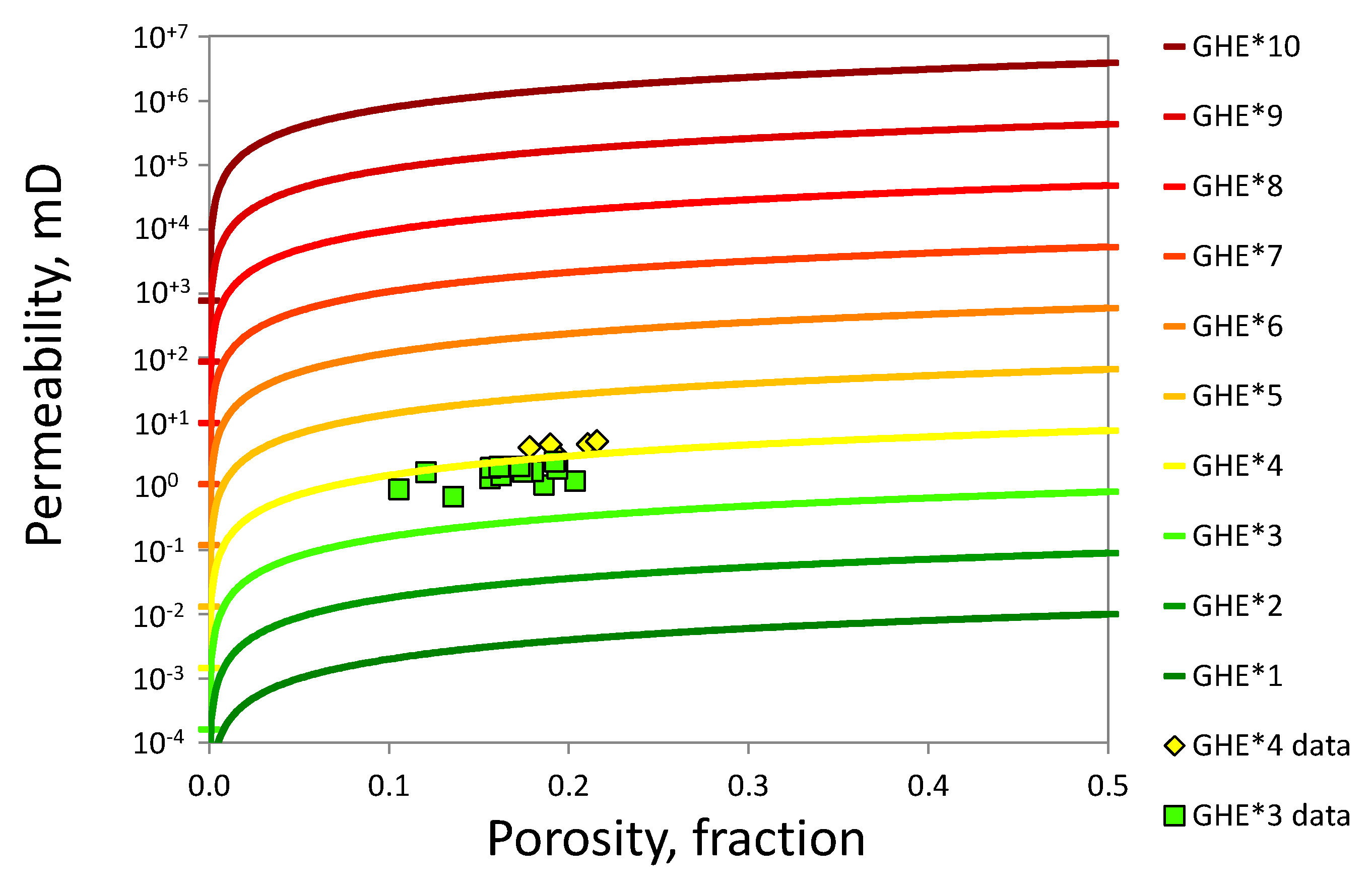
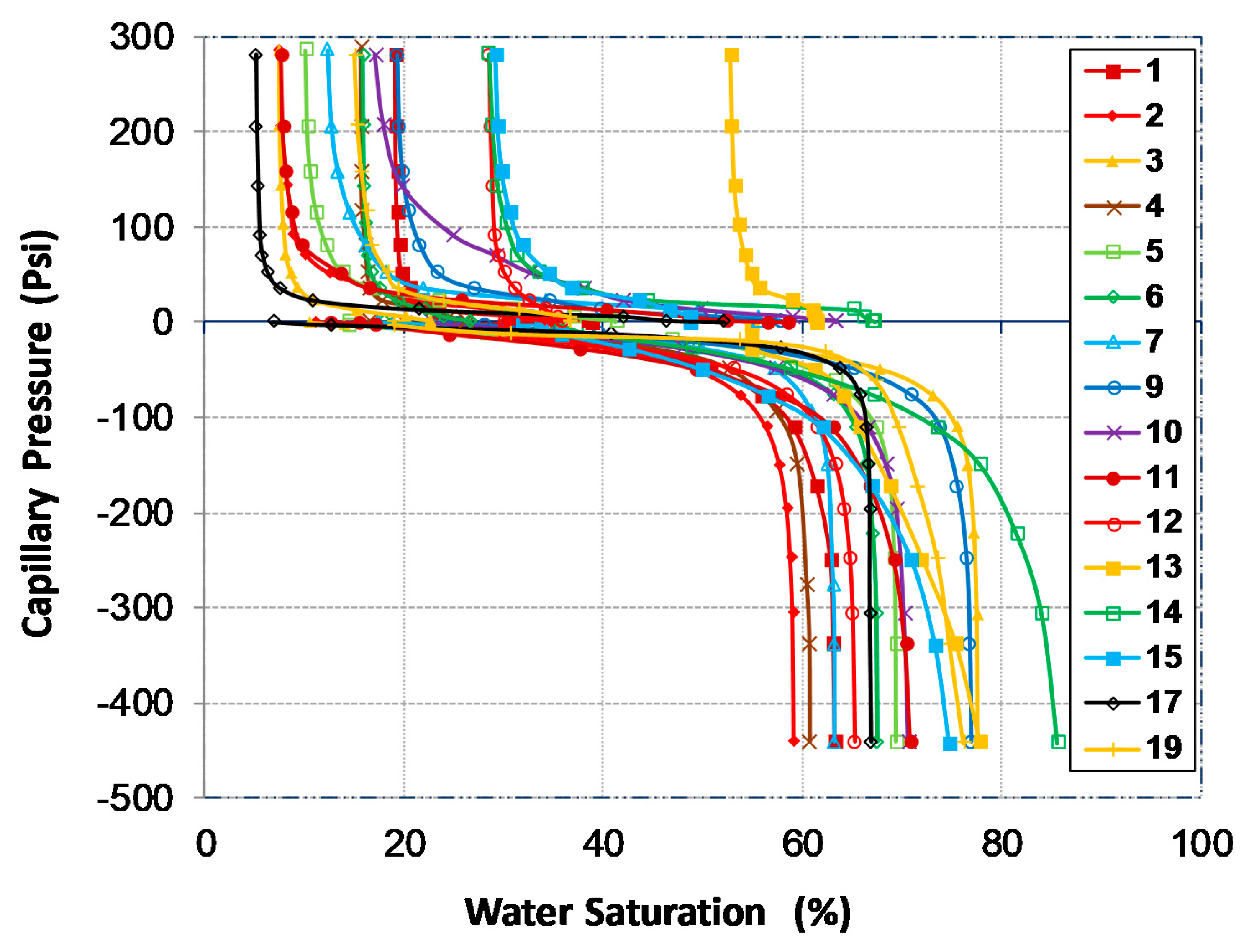
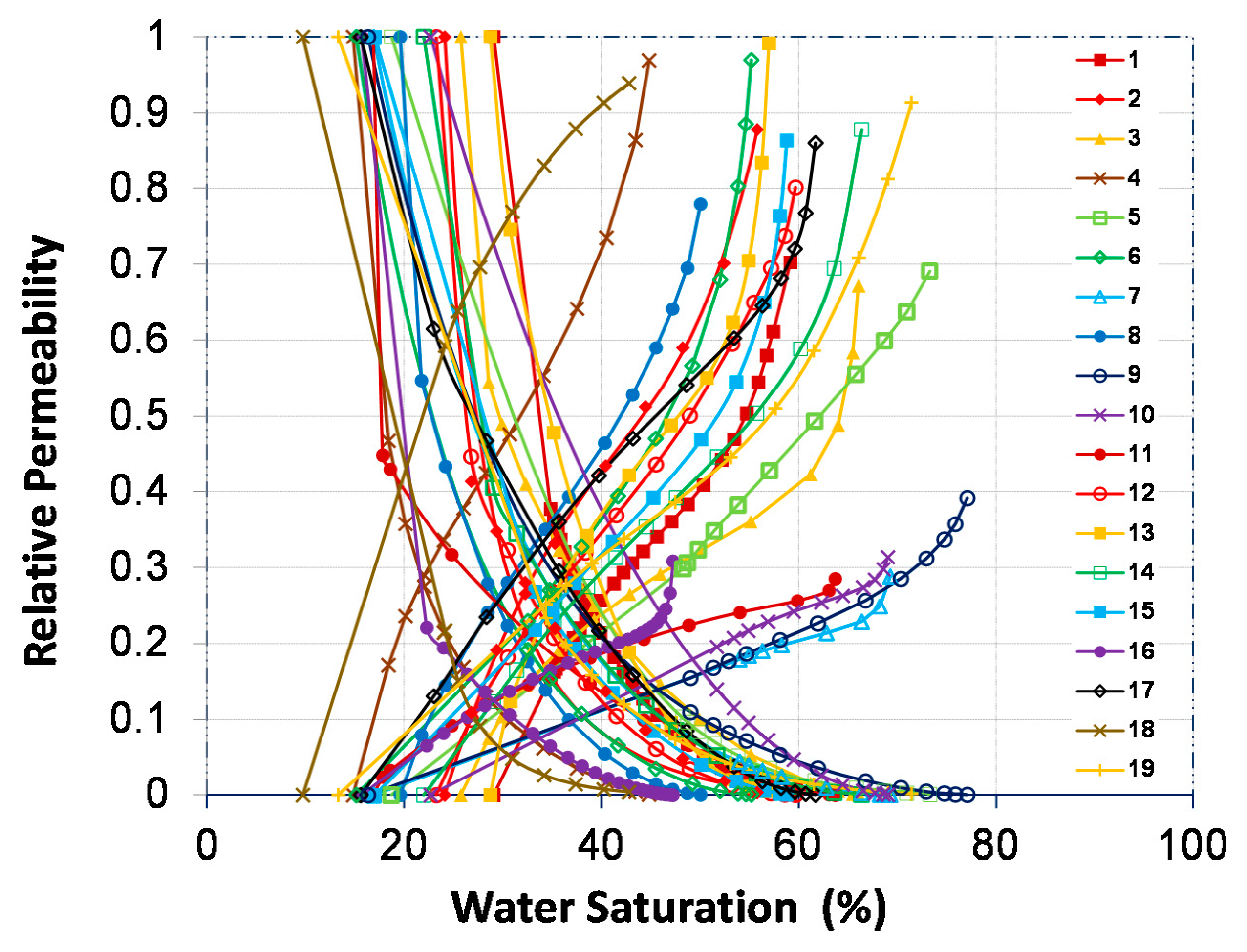
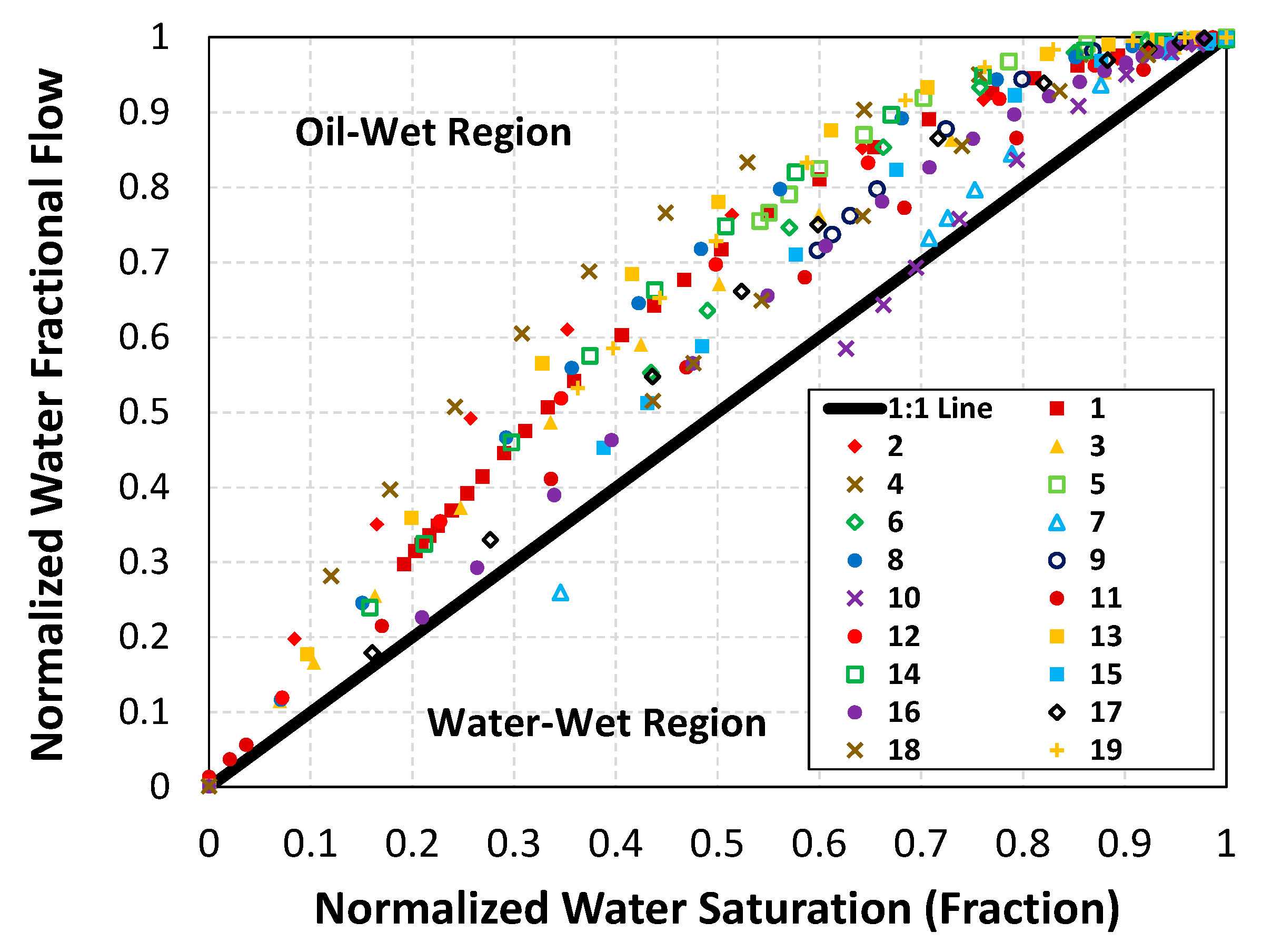

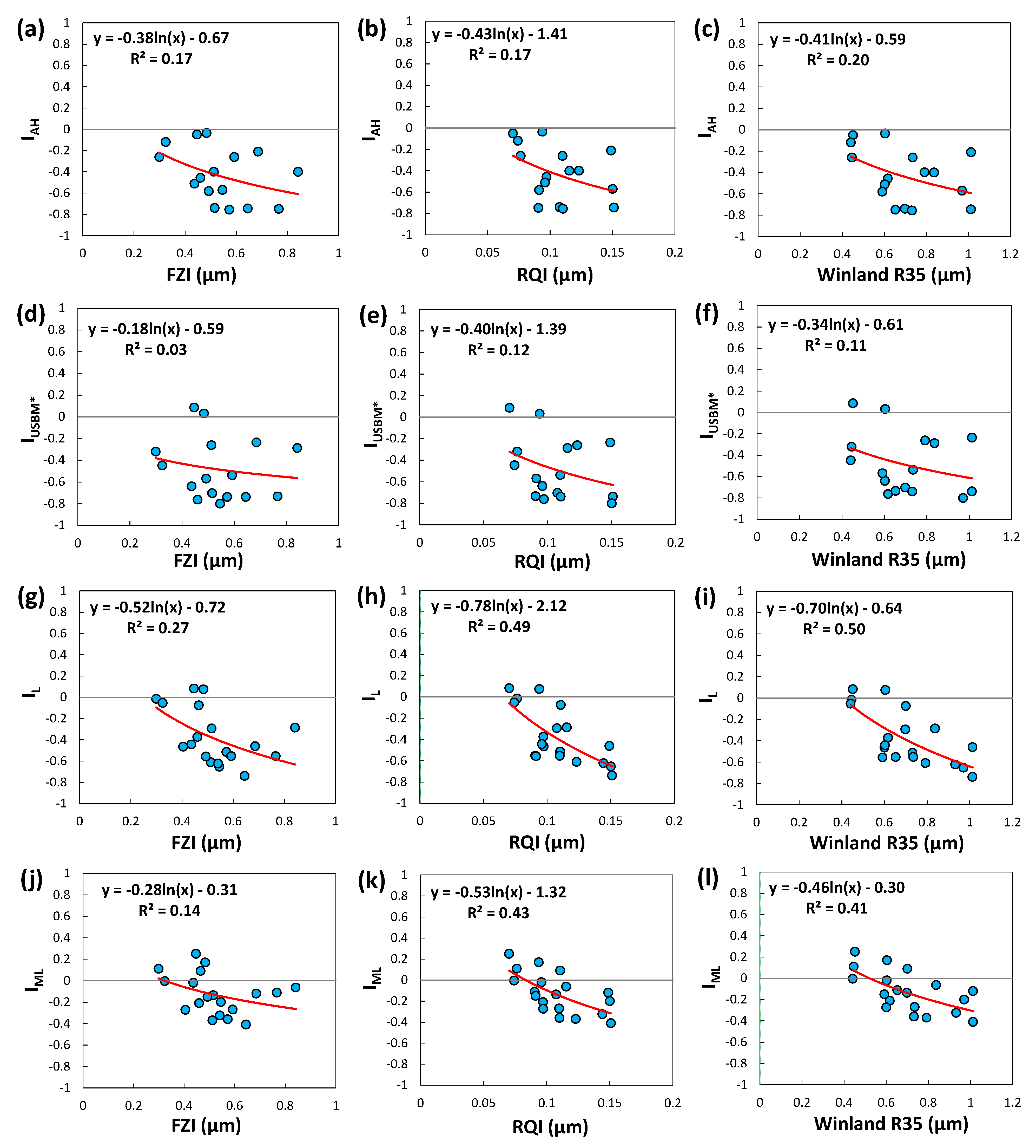
| Plug No. | Depth (m) | Porosity (%) | Air Permeability (mD) | RQI (μm) | GHE* Class |
|---|---|---|---|---|---|
| 1 | 2775.67 | 17.45 | 1.67 | 0.097 | 3 |
| 2 | 2776.08 | 19.38 | 2.98 | 0.123 | 4 |
| 3 | 2781.26 | 17.27 | 2.03 | 0.108 | 3 |
| 4 | 2799.48 | 18.98 | 4.39 | 0.151 | 4 |
| 5 | 2802.05 | 12.06 | 1.63 | 0.115 | 3 |
| 6 | 2804.33 | 10.57 | 0.88 | 0.091 | 3 |
| 7 | 2807.76 | 13.59 | 0.68 | 0.070 | 3 |
| 8 | 2824.54 | 19.38 | 1.86 | 0.097 | 3 |
| 9 | 2830.41 | 20.35 | 1.20 | 0.076 | 3 |
| 10 | 2834.6 | 16.23 | 1.45 | 0.094 | 3 |
| 11 | 2839.77 | 18.63 | 1.04 | 0.074 | 3 |
| 12 | 2843.74 | 16.14 | 1.99 | 0.110 | 3 |
| 13 | 2843.80 | 21.57 | 4.93 | 0.150 | 4 |
| 14 | 2846.00 | 15.66 | 1.92 | 0.110 | 3 |
| 15 | 2846.15 | 18.01 | 1.68 | 0.111 | 3 |
| 16 | 2850.66 | 19.22 | 2.39 | 0.149 | 4 |
| 17 | 2850.72 | 17.84 | 4.01 | 0.144 | 4 |
| 18 | 2851.23 | 21.05 | 4.44 | 0.091 | 3 |
| 19 | 2856.82 | 15.63 | 1.32 | 0.096 | 3 |
| Property | Water Density (gr./cc) | Oil Density (gr./cc) | Interfacial Tension (dyne/cm) | Water Viscosity (cp) | Oil Viscosity (cp) | |
|---|---|---|---|---|---|---|
| Test | ||||||
| Primary drainage capillary pressure at 50 °C | 1.125 | 0.857 | 26.79 | - | 3.29 | |
| Imbibition/secondary drainage capillary pressure at 25 °C | 1.145 | 0.731 | - | 1.36 | 2.44 | |
| Relative permeability at 25 °C | 1.145 | 0.731 | - | 1.36 | 2.44 | |
| Plug No. | Amott Water Index | Amott Oil Index | Amott–Harvey Index | USBM Index | USBM* Index |
|---|---|---|---|---|---|
| 1 | 0.09 | 0.55 | −0.46 | −0.87 | −0.76 |
| 2 | 0.07 | 0.47 | −0.40 | −0.23 | −0.26 |
| 3 | 0.04 | 0.78 | −0.74 | −0.76 | −0.70 |
| 4 | 0.02 | 0.76 | −0.74 | −0.82 | −0.74 |
| 5 | 0.07 | 0.47 | −0.40 | −0.26 | −0.29 |
| 6 | 0.04 | 0.79 | −0.75 | −0.81 | −0.73 |
| 7 | 0.10 | 0.15 | −0.05 | 0.08 | 0.09 |
| 8 | N.A. | N.A. | N.A. | N.A. | N.A. |
| 9 | 0.07 | 0.33 | −0.26 | −0.29 | −0.32 |
| 10 | 0.10 | 0.14 | −0.04 | 0.03 | 0.03 |
| 11 | 0.08 | 0.20 | −0.12 | −0.42 | −0.45 |
| 12 | 0.04 | 0.80 | −0.76 | −0.82 | −0.74 |
| 13 | 0.08 | 0.65 | −0.57 | −0.95 | −0.80 |
| 14 | 0.06 | 0.32 | −0.26 | −0.52 | −0.54 |
| 15 | 0.06 | 0.57 | −0.51 | −0.68 | −0.64 |
| 16 | N.A. | N.A. | N.A. | N.A. | N.A. |
| 17 | 0.03 | 0.24 | −0.21 | −0.21 | −0.24 |
| 18 | N.A. | N.A. | N.A. | N.A. | N.A. |
| 19 | 0.07 | 0.65 | −0.58 | −0.56 | −0.57 |
| Sample | * | CS (%) | RCS (%) | Qualitative Methods | Quantitative Methods | |||||||
|---|---|---|---|---|---|---|---|---|---|---|---|---|
| Craig’s First Rule | Craig’s Second Rule | Craig’s Third Rule | Modified Craig’s Second Rule | Normalized Water Fractional Flow Curve | IL | IML | ||||||
| 1 | 0.70 | 38.9 | 29.1 | 40.9 | 44.1 | OW | OW | WW | OW | OW | −0.37 | −0.21 |
| 2 | 0.88 | 31.3 | 24.1 | 44.2 | 40.0 | OW | OW | WW | OW | OW | −0.61 | −0.37 |
| 3 | 0.67 | 41.0 | 25.8 | 34.0 | 45.9 | OW | OW | WW | OW | OW | −0.29 | −0.14 |
| 4 | 0.97 | 21.7 | 14.8 | 55.2 | 29.8 | OW | OW | OW | OW | OW | −0.74 | −0.41 |
| 5 | 0.69 | 40.8 | 18.7 | 26.7 | 46.0 | OW | OW | - | OW | OW | −0.29 | −0.06 |
| 6 | 0.97 | 31.8 | 15.2 | 44.8 | 35.2 | OW | OW | - | OW | OW | −0.55 | −0.11 |
| 7 | 0.29 | 46.5 | 16.9 | 30.7 | 43.1 | WW | OW | - | WW | WW | 0.08 | 0.25 |
| 8 | 0.78 | 29.2 | 19.6 | 50.0 | 34.8 | OW | OW | - | OW | OW | −0.46 | −0.27 |
| 9 | 0.39 | 45.8 | 16.4 | 22.9 | 46.7 | - | OW | - | OW | OW | −0.02 | 0.11 |
| 10 | 0.31 | 49.3 | 22.7 | 31.0 | 45.9 | - | OW | WW | WW | WW | 0.07 | 0.17 |
| 11 | 0.28 | 36.6 | 16.9 | 36.3 | 40.3 | WW | OW | - | OW | OW | −0.05 | 0.00 |
| 12 | 0.80 | 33.7 | 23.3 | 40.3 | 41.5 | OW | OW | WW | OW | OW | −0.51 | −0.34 |
| 13 | 0.99 | 38.3 | 28.7 | 43.0 | 42.9 | OW | OW | WW | OW | OW | −0.65 | −0.20 |
| 14 | 0.88 | 36.4 | 22.0 | 33.6 | 44.2 | OW | OW | WW | OW | OW | −0.55 | −0.27 |
| 15 | 0.86 | 34.6 | 17.1 | 41.2 | 37.9 | OW | OW | - | OW | OW | −0.44 | −0.02 |
| 16 | 0.31 | 29.1 | 15.7 | 52.7 | 31.5 | - | OW | - | OW | OW | −0.08 | 0.09 |
| 17 | 0.86 | 34.0 | 15.6 | 38.3 | 38.7 | OW | OW | - | OW | OW | −0.46 | −0.12 |
| 18 | 0.94 | 20.2 | 9.7 | 57.2 | 26.3 | OW | OW | OW | OW | OW | −0.62 | −0.33 |
| 19 | 0.91 | 34.0 | 13.3 | 28.6 | 42.4 | OW | OW | OW | OW | OW | −0.56 | −0.15 |
Publisher’s Note: MDPI stays neutral with regard to jurisdictional claims in published maps and institutional affiliations. |
© 2021 by the authors. Licensee MDPI, Basel, Switzerland. This article is an open access article distributed under the terms and conditions of the Creative Commons Attribution (CC BY) license (https://creativecommons.org/licenses/by/4.0/).
Share and Cite
Faramarzi-Palangar, M.; Mirzaei-Paiaman, A.; Ghoreishi, S.A.; Ghanbarian, B. Wettability of Carbonate Reservoir Rocks: A Comparative Analysis. Appl. Sci. 2022, 12, 131. https://doi.org/10.3390/app12010131
Faramarzi-Palangar M, Mirzaei-Paiaman A, Ghoreishi SA, Ghanbarian B. Wettability of Carbonate Reservoir Rocks: A Comparative Analysis. Applied Sciences. 2022; 12(1):131. https://doi.org/10.3390/app12010131
Chicago/Turabian StyleFaramarzi-Palangar, Mohsen, Abouzar Mirzaei-Paiaman, Seyyed Ali Ghoreishi, and Behzad Ghanbarian. 2022. "Wettability of Carbonate Reservoir Rocks: A Comparative Analysis" Applied Sciences 12, no. 1: 131. https://doi.org/10.3390/app12010131
APA StyleFaramarzi-Palangar, M., Mirzaei-Paiaman, A., Ghoreishi, S. A., & Ghanbarian, B. (2022). Wettability of Carbonate Reservoir Rocks: A Comparative Analysis. Applied Sciences, 12(1), 131. https://doi.org/10.3390/app12010131








